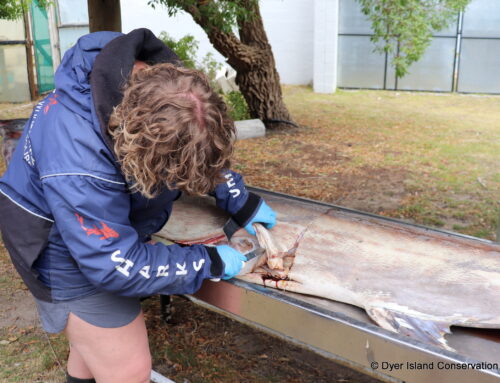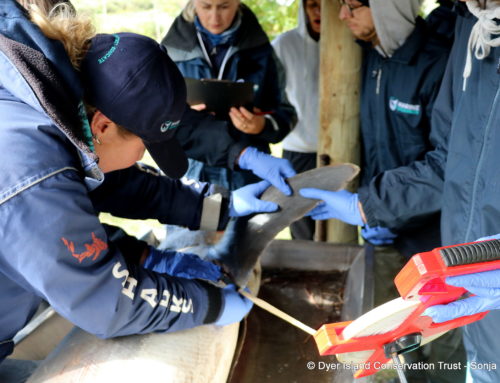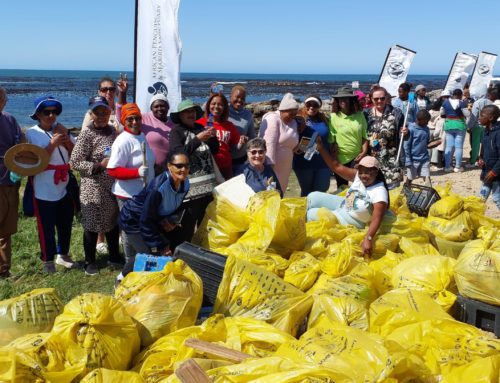GREAT WHITE SHARKS SWIM THROUGH KELP
April 03, 2019 OLIVER JEWELL
It’s been more than five years since I moved my life from Gansbaai and the Dyer Island Conservation Trust, first to Europe and then Australia, which I still find incredible to believe… how time flies… But I remain an associate researcher with the Trust and Marine Dynamics and I’m proud to announce our latest paper in collaboration between the Centre for Sustainable Aquatic Ecosystems, Murdoch University, Monterey Bay Aquarium’s Conservation Research Team and Hopkins Marine Station, Stanford University has just been released in Biology Letters. In 2014, we launched a research expedition to the very same areas I’d spent many hours of my life tracking white sharks or guiding for Marine Dynamics Shark Tours around Dyer Island. We had already discovered this region hosted the largest aggregation of white sharks in the world, that they used small areas around the island when foraging, performed two distinct predatory behavioural modes and that in response to the presence of white sharks, seals would use kelp forest as a refuge. What we didn’t know is quite how all these interactions played out underwater.
Cue fin-cams! Or more specifically Animal-borne video and environmental data collection systems (AVEDs for short). These are specially designed tags which include ‘daily-diaries’ similar to Fitbits that log the movements of the animals in three-dimensions while the camera allows us to see what the shark does.
We first used AVEDS on white sharks in 2013 with Dr’s Taylor Chapple and Adrian Gleiss at the beginning of this collaboration and our initial results were published in Animal Biotelemetry and screened on National Geographic. However, by the time we started that year, the sharks were already inshore, meaning we were unable to investigate the interactions at the island. Fortunately, we were able to return a year later with Salvador Jorgensen and some of his experimental AVEDs from Monterey Bay Aquarium Research Institute (MBARI) and the team from Customized Animal Tracking Solutions (CATS) with theirs. We captured repeated use of kelp forest areas by seven of the eight white sharks in the study, while the eighth swam away from Dyer Island. The sharks would move into areas of dense kelp, squeezing through narrow gaps and where necessary, smashing directly through the kelp to get to the other side of it. One shark encountered several Cape fur seals, and after they made it very clear to the shark they’d seen it by blowing bubble streams up at it and darting further into the kelp, the shark went after them, pushing straight through the kelp line and raising its activity considerably. The seals can then be seen taking refuge in the surface fronds just as they were hypothesised to in the earlier study, escaping the shark for at least the time being.
Eventually, the shark went so deep into the kelp the fronds pulled the AEVD from its fin, ending one of the most exciting passages of footage we’ve ever seen from these tags agonisingly before we found out if this shark caught her dinner that afternoon.
Long-term Dyer Island Conservation Trust and Marine Dynamics collaborator David ‘Ed’ Edwards also works on the longer-term version of this project, and we’ll have some exciting new research to share in the future. For this research, he’s taken on a completely abstract approach to communicating the findings in the form of designing a shark made of kelp. The results are stunning, and we’ll be sharing more of these images in the coming days online. “This was a more abstract way of visualising the findings of the paper and opened the door to some interesting visuals”, according to David.
This is just the tip of the iceberg in terms of what more we can learn from these animals using new technology. We’re already changing perspectives on our understanding of these incredible sharks. Keep following us and we’ll keep you posted as we find out and share more on them!
You can follow more of Oli’s research on Twitter.
Paper Reference:
Jewell OJD, Gleiss AC, Jorgensen SJ, Andrzejaczek S, Moxley JH, Beatty SJ, Wikelski M, Block BA, Chapple TK. 2019 Cryptic habitat use of white sharks in kelp forest revealed by animal-borne video. Biol. Lett. 20190085.
Image captions:
1. Screenshots of a white shark at Dyer Island with a CATS Cam attached. The shark encounters several Cape fur seals in kelp forest, that blow bubbles up at it
and dart further into kelp in response. The shark then swims through the bubbles and then the kelp in response, before the seals are spotted taking refuge in
the surface fronds – credit Jewell et al. (2019) Biology Letters
2. White shark at Dyer Island with an MBARI CafeCam and CATS Diary logger attached – credit Jewell et al. (2019) Biology Letters
3. Cover work for the new research with Ed’s conceptual kelp shark sculpture







